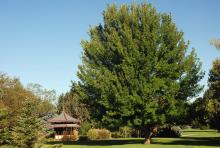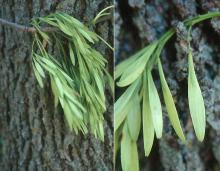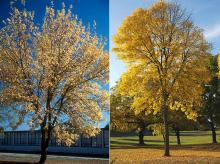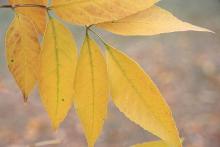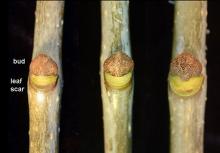Fraxinus pennsylvanica
Common name:
Green Ash
Pronunciation:
FRAKS-i-nus pen-sil-VAN-i-ka
Family:
Oleaceae
Genus:
Type:
Broadleaf
Native to (or naturalized in) Oregon:
No
- Broadleaf deciduous tree, 50-60 ft tall × 40 ft wide, (15-18 m × 14 m), pyramidal in youth, developing a spreading habit at maturity. Leaves to about 30 cm long, opposite, pinnately compound, 5-9 (usually 7) leaflets, each leaflet 10-15 cm long, ovate to oblong-lanceolate, margin crenate-serrate (mix of blunt and sharp teeth) or entire, dark green above, essentially glabrous above and pubescent below (sometimes only on major veins); fall color yellow, golden, or bronzy. Leaf scars are semicircular, with the upper line nearly straight across but sometimes there is a slight notch in this line. The upper pair of lateral buds are very close to the terminal bud (Farrar, 1995). Flowers dioecious, i.e., male and female trees, appearing as leaves unfold, in compact clusters, male (staminate, pollen) flowers green and purple, female (pistilate, seed) flowers greenish. Fruit (samara) is 2.5-5 cm long and about 0.5 cm wide, the wing extends about halfway down the fruit.
- Sun. Grows nearly anywhere, hence its (over?) popularity. Sometimes seedling grown and any female trees have the potential to produce a large number of seeds and be a messy nuisance.
- Hardy to USDA Zone 3 The native range of the species extends from Nova Scotia to Manitoba, south to Florida and Texas (includes Pennsylvania, hence pennsylvanica, meaning from Pennsylvania). Sometimes the Latin form is given as pensylvanica; the one "n" form is an old spelling of the former colony.
-
Many selections, some of the more common ones include:
- Cimmaron® - seedless; has red to orange-red fall color. Sold as a Green Ash but may actually be a selection of F. americana, White Ash (Jacobson, 1996). Oregon State Univ. campus: row planted north of the softball field on Western Ave.
- Leprechaun™ (syn. 'Johnson') - a true genetic dwarf found in about 1983 at the Johnson nursery, Menomonee Falls, Wisconsin; often it is sold grafted to a standard trunk at a height of 6 ft (1.8 m). Oregon State Univ. campus: several on the east side of 35th St. just south of Jackson Ave.
- ‘Marshall’ (syn. ‘Marshall's Seedless’) - is by far the most commonly planted Green Ash cultivar. It is a seedless cultivar, but visually identical to a regular male green ash (Jacobson, 1996). "Marshall" refers to Marshall nursery of Arlington, Nebraska and/or George A. Marshall of that nursery.
- ‘Patmore’ - seedless, upright branching, symmetrical, oval crown, leaves glossy dark green, very winter hardy (USDA Zone 2b/3a).
- ‘Summit’ - generally seedless; pyramidal with a strong central leader, leaves medium green, leaflets pointed, narrow, fall color yellow, may drop its leaves before ‘Marshall’; winter hardy, USDA Zone 3b. Oregon State Univ. campus: north side of Buxton, on Jefferson, also inside this "dorm quad".
- Urbanite® - seedless; dense, broadly pyramidal, leaves thick, glossy, bronze colored in fall. Dirr (1998, p. 396) questions whether this is a Green Ash. Dirr (1998, p. 396) has the following to say about this selection and another, ‘Emerald’; "I know this may sound like heresy but evaluating 'Emerald' and Urbanite® I wondered if they were green ashes; safe to place then in the Red Ash category or move them to White Ash". Oregon State Univ. campus: two rows in the parking lot just west of the west stands of Reser Stadium.
- At one time Fraxinus pennsylvanica was known as the Red Ash and F. p. var. lanceolata was called the Green Ash. (The Green Ash is sometimes named F. p. var. subintegerrima.) In his Manual of the Trees of North America (1949), C. S. Sargent points out that in the east the glabrous leaves and glabrous branchlets of the Green Ash "appear distinct from the Red Ash". But more westward there is a slight pubescence on the leaves and branchlets, making it impossible to distinguish between the two. He states that the fall color of Red Ash foliage is "yellow or rusty brown", others call it yellowish-brown. Most authorities now lump these two types of ash into a single species, Fraxinus pennsylvanica, with a the common name of Green Ash (Dirr, 1998).
- Oregon State Univ. campus: several (cultivar 'Marshall') located at southeast corner of Campus Way and 35th St., west of USDA Forage Seed lab.

